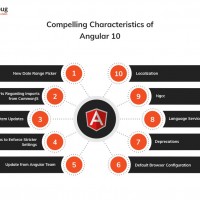Why Angularjs Is Top Choice For Your Next Project
- December 2, 2020
-
2133 Views
- by Ishan Vyas

Significant digital transformation has resulted from the emergence of modern browsers and network technology. A JavaScript platform such as Angular offers an MVVM architecture for the development of immersive web and mobile applications with declarative UI, precise code, single-page app (SPA) modular system support and much more to include rich user interfaces, ease of access, speed and productivity.
Let’s dive deeper now to see what AngularJS is and why you should choose this technology for your development projects.
What Is Angular Technology?
The Angular technology, developed by Google in 2009, has been one of the most common JavaScript frameworks to the degree that it is simple to use, offers a high level of simplistic analysis of the whole development phase and embraces the new JavaScript (ES6) standards. Over the years, designing online and smartphone applications that are flexible as well as sensitive, AngularJS became one of the most advanced technologies.
Most Outstanding Characteristics Of The Latest Version Of Angular – Angular 10

New Date Range Picker
In the latest version of AngularJS, you can use the mat-date-range-input and mat-date-range-picker components in Angular Content to begin using the new date range selector.
Alerts Regarding Imports from CommonJS
Essentially, ECMAScript bundling is preferred over CommonJS for optimum performance and speed. With this latest version of Angular, the belief is that seeing these alerts would start nudging developers to the most optimal alternative of using an ECMAScript module (ESM) bundle if your build has a CommonJS pile.
Ecosystem Updates
The below modules were revised and unified in the latest version 10 of Angular:
- The TypeScript edition was revised to edition 3.9 of TypeScript
- The edition of TSLib was also upgraded to TSLib version 2.0
- Modified TSLint to version 6.0
Options to Enforce Stricter Settings
So you use the latest ng syntax anytime you want to build a new Angular project, and now you can apply a strict flag like this to that:
Latest nameOfApp ng —strictly strict
Update from Angular Team
The Angular team has now been up and going as it reported to solve a massive 700 problems across modules, and the system has minimized open issues for various Angular projects.
Default Browser Configuration
The browser setup has been changed to prevent specific browsers, starting with the latest version 10 of Angular.
Deprecations
The Angular Box Format no longer contains ESM5 or FESM5 packages as of the latest update 10.
Language Service
The language-service-specific converter allows several types of files to be tested using the project framework that produces ScriptInfos as needed.
Ngcc
A software-based entry-point finder was introduced with this angular 10 update, which is programmed just to process record points that can only be given by a programme specified by a tsconfig.json file.
Localization
One of the better features of Angular 10 is that it allows the aggregation of several translation files in the new Angular update, which could only load one file in past models.
History of the Angular Versions
ANGULAR 1.X (ANGULARJS)
Angular1.x is usually referred to as “Angular.js” or “AngularJS.” It is a JavaScript-based open-source front-end web application framework.
ANGULAR 2
Angular 2 is a thorough overhaul by the same team that developed AngularJS. It is written in TypeScript. The smartphone is not supported by Angular 1.x, where Angular 2 is smartphone-oriented.
ANGULAR 3
Angular 3 was missed because the Angular team required the angular update to be compatible with the update of the angular router. The mismatch in the version between @angular/core, @angular/compiler and @angular/router dependencies is the explanation behind this.
ANGULAR 4
In March 2017, Angular 4 was published. On most apps, it is compatible with Angular 2. Angular 4 does not have significant improvement from Angular 2, and it is not a complete overhaul of Angular 2.
ANGULAR 5
In November 2017, Angular 5 was revealed and it aimed to make Angular simpler and easier to use.
ANGULAR 6
Angular 6 with Angular CLI 6 and Material 6 was released in May 2018 and is a significant milestone and is the Angular team’s new update after Angular 5.
ANGULAR 7
Angular CLI has been upgraded to v7.0.2 with certain features, such as now, when typing commands such as ng-add, ng-new and @angular/material, it can prompt users to explore built-in SCSS support and routing.
ANGULAR 8
Differential loading of modern JavaScript, dynamic importing for lazy paths, web worker support, TypeScript 3.4 support, and Angular Ivy as an opt-in demo are the most significant features of Angular 8.
ANGULAR 9
This is a significant Angular upgrade, introducing the latest and updated compiler and framework of Ivy, faster coding, easier debugging, and many more upgrades. 5 Reasons with your next project to select angular growth.
5 Reasons to Choose Angular Development for your Next Project
After careful analysis, we have highlighted the top five benefits of using Angular development for your projects.
Smoother Visitor Navigation
For growth, AngularJS uses a more straightforward MVC structure that reduces the load time of the application. This is one of the important causes why developers and businesses choose Angular. By eliminating the need for complex programming, it ensures fast growth. Also, the programming for the application is handled by instructions. They deliver the production of lighter and quicker applications. A substantial increase in income for the organizations is generated by a good millisecond change in the page loading speed.
An Extensible And Modular Platform
AngularJS requires several modules for a single framework to be built. This is where the increasing element is dependent on the other. It recognizes the need for an additional module as one of the advantages of the Angular system. Thus, for efficient execution of the framework, it should be paired with other modules. This is one of the many other considerations why corporations prefer AngularJS.
Narrower codes
Angular introduces a declarative paradigm for application development. It allows a more in-depth interpretation of how the programme performs before its implementation, helping the programme to be streamlined. For example, by deleting the unusable code automatically. The simplicity of the code is feasible with AngularJS. To incorporate data structures, even the MVC architecture does not require complicated rows of codes.
Efficient Compilation With TypeScript
The TypeScript language, a JavaScript superscript, guarantees that Angular applications are created. As it supports forms (primitives, interfaces, and more), it provides high security. And, in the early stages, it often helps to capture and remove mistakes when writing codes or executing maintenance activities. Two compile modes are possible with TypeScript: EcmaScript 3 (IE6 compatibility) and EcmaScript 5 (IE9 compatibility). Thus, Angular takes advantage of the rigour and versatility of the TypeScript language. Enhanced navigation, autocompletion and refactoring facilities are provided by TypeScript.
Architecture Component-based
The Angular framework has an interface focused on a part. Each feature has a particular definition and behaviour that is independent of its setting. Inside the production team, you will delegate the design of the modules, and if an aspect does not meet the requirements, removing it becomes simple.
Conclusion
Angular programming is an excellent alternative for constructing dynamic and varied visual elements, as mentioned above. At Citrusbug, we have extensive experience in helping organizations build applications through iterations by leveraging the benefits of the Angular architecture.
So, if you are still wondering why use Angular and if it is best for your specifications for web growth, feel free to contact us at Citrusbug. Our unrivalled services will help your company leverage on growth and innovation in the design, creation, and deployment of custom web apps or new web services.
Angular constantly continues to evolve & we continue to compare its new versions like Angular 12 vs Angular 13 to acknowledge you with its exciting features and improvements. To learn more about the specific Angular versions, refer to our blog post comparing angular 9 vs angular 10.





 SaaS Development
SaaS Development Web Application Development
Web Application Development Mobile Application Development
Mobile Application Development Custom Software Development
Custom Software Development Cloud Development
Cloud Development DevOps Development
DevOps Development MVP Development
MVP Development Digital Product Development
Digital Product Development Hire Python Developers
Hire Python Developers Hire Django Developers
Hire Django Developers Hire ReactJS Developers
Hire ReactJS Developers Hire AngularJS Developers
Hire AngularJS Developers Hire VueJS Developers
Hire VueJS Developers Hire Full Stack Developers
Hire Full Stack Developers Hire Back End Developers
Hire Back End Developers Hire Front End Developers
Hire Front End Developers AI Healthcare Software Development & Consulting
AI Healthcare Software Development & Consulting Healthcare App Development
Healthcare App Development EHR Software Development
EHR Software Development Healthcare AI Chatbot Development
Healthcare AI Chatbot Development Telemedicine App Development Company
Telemedicine App Development Company Medical Billing Software Development
Medical Billing Software Development Fitness App Development
Fitness App Development RPM Software Development
RPM Software Development Medical Device Software Development
Medical Device Software Development Patient Engagement Software Solutions
Patient Engagement Software Solutions Healthcare IT Consulting
Healthcare IT Consulting Mental Health App Development
Mental Health App Development Lending Software Development Services
Lending Software Development Services Payment Gateway Software Development
Payment Gateway Software Development Accounting Software Development
Accounting Software Development Mobile Banking Software Development
Mobile Banking Software Development Supply Chain Management Software Development
Supply Chain Management Software Development Fleet Management Software Development
Fleet Management Software Development Warehouse Management Software Development
Warehouse Management Software Development LMS Development
LMS Development Education App Development
Education App Development Inventory Management Software Development
Inventory Management Software Development Property Management Software Development
Property Management Software Development Real Estate CRM Software Development
Real Estate CRM Software Development Real Estate Document Management Software
Real Estate Document Management Software Construction App Development
Construction App Development Construction ERP Software Development
Construction ERP Software Development

















